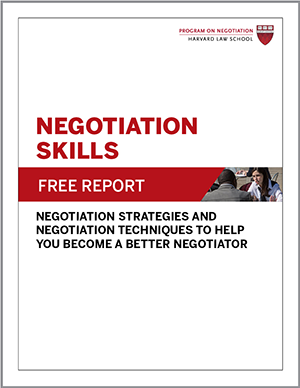The ladder of inference is a model of decision making behavior originally developed by Chris Argyris and Donald Schoen and elaborated upon in the context of negotiation by Program on Negotiation co-founder Bruce Patton in his book Difficult Conversations, co-authored with fellow Program on Negotiation faculty members Douglas Stone and Sheila Heen. The model describes how individuals use available data to make decisions. The ladder of inference describes how a negotiator, or any decision maker, relies upon her personal knowledge, or observable data, up the ladder of inference to the next stage, which is selected data.
This is the data that the decision maker chooses to pay specific attention to, for one reason or the other. From this rung of the ladder the negotiator moves to the phase of reasoning and interpreting the available data based upon the selected data she has focused on. At this stage “past experiences, assumptions, and implicit rules influence the meaning I make of the data” (The Handbook of Dispute Resolution, Robert Bordone). After this stage, decision makers begin to draw conclusions based upon the culmination of the preceding three rungs, and from there actions are taken.
Beyond Winning by Robert Mnookin, Scott Peppett, and Robert S. Tulumello – A guide to dispute resolution that can help negotiators understand the conflict resolution process and the pressures influencing lawyers and clients.
The Art and Science of Negotiation by Howard Raiffa – A guide to negotiation using diagrams, case studies, and in-depth analysis of bargaining dynamics.
Getting to YES by Roger Fisher and William Ury – The definitive guide to negotiating agreements in any avenue of life, whether it is work, family, business, or personal matters. Written by Program on Negotiation founder Roger Fisher and based upon the work of the Harvard Negotiation Project, Getting to YES offers a groundbreaking approach that helps negotiators separate the person from the problem, focus on interests rather than stated positions, and approach bargaining with an integrative, cooperative mindset.
The Handbook of Dispute Resolution by Robert Bordone – An overview of the disciplines and theories, concepts, and practices that comprise the field of Alternative Dispute Resolution. With over fifty contributing authors, The Handbook of Dispute Resolution interrogates the relationship between Alternative Dispute Resolution and the legal system and “challenges the legal community’s existing understanding of and its relationship to ADR concepts, subject matter, and even its methods.”
Difficult Conversations by Sheila Heen, Bruce Patton, and Doug Stone – A roadmap for conducting the most difficult, challenging conversations one will face, whether in business or in personal life. Based on research from the Harvard Negotiation Project, this book offers guidance on beginning a difficult conversation, maintaining dialogue without resorting to entrenched positions, and keeping the conversation focused on what matters rather than on what happens.
The Manager as Negotiator by David Lax and James Sebenius – An approach to negotiation for attorneys, executives, and diplomats based upon research from Harvard University.
What do you think of this list? Would you add any other resources? Leave us a comment.















